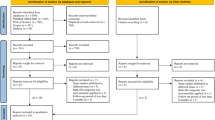Abstract
Objectives
The purpose of this systematic review was to compare the clinical performance of bulk-fill resin composites with conventional resin composites used for direct restorations of posterior teeth.
Methods
This review followed the PRISMA statement. This review was registered at PROSPERO (registration number CRD42016053436). A search of the scientific literature was performed by two independent reviewers using the PubMed/MEDLINE, Embase, The Cochrane Library, and Web of Science databases from commencement until January 2018. The research question was “Do bulk-fill resin composites have a clinical performance comparable to conventional resin composites in posterior restorations?” Only studies evaluating class I and II direct restorations in permanent teeth with a follow-up period of at least 1 year were included. The RevMan 5 program was used for meta-analysis, calculating the relative risk (RR) and 95% confidence interval (CI) of the dichotomous outcome (restoration failure or success).
Results
Ten articles were selected, comprising 941 analyzed restorations. The mean follow-up period was 33.6 months (12–72 months). No statistically significant differences in the failure rate were observed between conventional and base/flowable bulk-fill resin composites (p = 0.31; RR 1.49; 95% CI 0.69–3.25) or full-body/sculptable bulk-fill resin composites (p = 0.12; RR 1.89; 95% CI 0.84–4.24).
Conclusions
The present systematic review and meta-analysis indicate similar clinical performances of bulk-fill and conventional resin composites over a follow-up period of 12 to 72 months.
Clinical significance
Based on the results of this study, the bulk-fill resin composites could be an alternative for direct restorations in posterior teeth. However, clinical trials of longer duration are required.




Similar content being viewed by others
References
Van Dijken JWV, Pallesen U (2013) A six-year prospective randomized study of a nano-hybrid and a conventional hybrid resin composite in class II restorations. Dent Mater 29:191–198. https://doi.org/10.1016/j.dental.2012.08.013
de Andrade A, Duarte R, FM e S et al (2014) Resin composite class I restorations: a 54-month randomized clinical trial. Oper Dent 39:588–594. https://doi.org/10.2341/14-067-C
Ástvaldsdóttir Á, Dagerhamn J, Van Dijken JWV et al (2015) Longevity of posterior resin composite restorations in adults—a systematic review. J Dent 43:934–954. https://doi.org/10.1016/j.jdent.2015.05.001
Schmidt M, Dige I, Kirkevang LL, Vaeth M, Hørsted-Bindslev P (2015) Five-year evaluation of a low-shrinkage Silorane resin composite material: a randomized clinical trial. Clin Oral Investig 19:245–251. https://doi.org/10.1007/s00784-014-1238-x
Opdam NJM, van de Sande FH, Bronkhorst E, Cenci MS, Bottenberg P, Pallesen U, Gaengler P, Lindberg A, Huysmans MCDNJM, van Dijken JW (2014) Longevity of posterior composite restorations: a systematic review and meta-analysis. J Dent Res 93:943–949. https://doi.org/10.1177/0022034514544217
Lynch CD, Opdam NJ, Hickel R, Brunton PA, Gurgan S, Kakaboura A, Shearer AC, Vanherle G, Wilson NH, Academy of Operative Dentistry European Section (2014) Guidance on posterior resin composites: Academy of Operative Dentistry—European section. J Dent 42:377–383. https://doi.org/10.1016/j.jdent.2014.01.009
Ferracane JL (2011) Resin composite—state of the art. Dent Mater 27:29–38. https://doi.org/10.1016/j.dental.2010.10.020
Fronza BM, Rueggeberg FA, Braga RR, Mogilevych B, Soares LES, Martin AA, Ambrosano G, Giannini M (2015) Monomer conversion, microhardness, internal marginal adaptation, and shrinkage stress of bulk-fill resin composites. Dent Mater 31:1542–1551. https://doi.org/10.1016/j.dental.2015.10.001
Kim RJY, Kim YJ, Choi NS, Lee IB (2015) Polymerization shrinkage, modulus, and shrinkage stress related to tooth-restoration interfacial debonding in bulk-fill composites. J Dent 43:430–439. https://doi.org/10.1016/j.jdent.2015.02.002
Sajnani A, Hegde M (2016) Leaching of monomers from bulk-fill composites: an in vitro study. J Conserv Dent 19:482–486. https://doi.org/10.4103/0972-0707.190020
Alrahlah A, Silikas N, Watts DC (2014) Post-cure depth of cure of bulk fill dental resin-composites. Dent Mater 30:149–154. https://doi.org/10.1016/j.dental.2013.10.011
Lopes GC, Baratieri LN, Monteiro S, Vieira LCC (2004) Effect of posterior resin composite placement technique on the resin–dentin interface formed in vivo. Quintessence Int 35:156–161
Flury S, Hayoz S, Peutzfeldt A, Hüsler J, Lussi A (2012) Depth of cure of resin composites: is the ISO 4049 method suitable for bulk fill materials? Dent Mater 28:521–528. https://doi.org/10.1016/j.dental.2012.02.002
Flury S, Peutzfeldt A, Lussi A (2014) Influence of increment thickness on microhardness and dentin bond strength of bulk fill resin composites. Dent Mater 30:1104–1112. https://doi.org/10.1016/j.dental.2014.07.001
Czasch P, Ilie N (2013) In vitro comparison of mechanical properties and degree of cure of bulk fill composites. Clin Oral Investig 17:227–235. https://doi.org/10.1007/s00784-012-0702-8
El-Safty S, Akhtar R, Silikas N, Watts DC (2012) Nanomechanical properties of dental resin-composites. Dent Mater 28:1292–1300. https://doi.org/10.1016/j.dental.2012.09.007
Van Ende A, De Munck J, Lise DP, Van Meerbeek B (2017) Bulk-fill composites: a review of the current literature. J Adhes Dent 19:95–110. https://doi.org/10.3290/j.jad.a38141
Alshali RZ, Silikas N, Satterthwaite JD (2013) Degree of conversion of bulk-fill compared to conventional resin-composites at two time intervals. Dent Mater 29:e213–e217. https://doi.org/10.1016/j.dental.2013.05.011
Didem A, Gözde Y, Nurhan Ö (2014) Comparative mechanical properties of bulk-fill resins. Open. J Compos Mater 4:117–121. https://doi.org/10.4236/ojcm.2014.42013
Miletic V, Peric D, Milosevic M, Manojlovic D, Mitrovic N (2016) Local deformation fields and marginal integrity of sculptable bulk-fill, low-shrinkage and conventional composites. Dent Mater 32:1441–1451. https://doi.org/10.1016/j.dental.2016.09.011
Higgins JPTGS (2009) Cochrane handbook for systematic reviews of interventions version 5.0.2 [updated September 2009]. In: Cochrane Collab available from www.cochrane--www.handbook.org
Moher D, Shamseer L, Clarke M et al (2015) Preferred reporting items for systematic review and meta-analysis protocols (PRISMA-P) 2015 statement. Syst Rev 4(1). https://doi.org/10.1186/2046-4053-4-1
Lemos CAA, Verri FR, Bonfante EA, et al (2017) Comparison of external and internal implant-abutment connections for implant supported prostheses. A systematic review and meta-analysis. J Dent 70: 14–22. https://doi.org/10.1016/j.jdent.2017.12.001
Atieh MA, Alsabeeha NH, Payne AG, et al (2015) Interventions for replacing missing teeth: alveolar ridge preservation techniques for dental implant site development. In: Cochrane Database Syst. Rev. p CD010176
Moraschini V, da Costa LS, dos Santos GO (2018) Effectiveness for dentin hypersensitivity treatment of non-carious cervical lesions: a meta-analysis. Clin Oral Investig 22:617–631. https://doi.org/10.1007/s00784-017-2330-9
Wilson MA, Cowan AJ, Randall RC, Crisp RJ, Wilson NH (2002) A practice-based, randomized, controlled clinical trial of a new resin composite restorative: one-year results. Oper Dent 27(5):423-429
Bayraktar Y, Ercan E, Hamidi MM, Çolak H (2017) One-year clinical evaluation of different types of bulk-fill composites. J Investig Clin Dent 8. https://doi.org/10.1111/jicd.12210
van Dijken JWV, Pallesen U (2016) Posterior bulk-filled resin composite restorations: a 5-year randomized controlled clinical study. J Dent 51:29-35. https://doi.org/10.1016/j.jdent.2016.05.008
van Dijken JWV, Pallesen U (2017) Bulk-filled posterior resin restorations based on stress-decreasing resin technology: a randomized, controlled 6-year evaluation. Eur J Oral Sci 125:303–309. https://doi.org/10.1111/eos.12351
Manhart J, Chen H-Y, Hickel R (2010) Clinical evaluation of the posterior composite Quixfil in class I and II cavities: 4-year follow-up of a randomized controlled trial. J Adhes Dent 12:237–243. https://doi.org/10.3290/j.jad.a17551
Karaman E, Keskin B, Inan U (2017) Three-year clinical evaluation of class II posterior composite restorations placed with different techniques and flowable composite linings in endodontically treated teeth. Clin Oral Investig 21:709–716. https://doi.org/10.1007/s00784-016-1940-y
Arhun N, Celik C, Yamanel K (2010) Clinical evaluation of resin-based composites in posterior restorations: two-year results. Oper Dent 35:387–404. https://doi.org/10.2341/09-345-C
Çolak H, Tokay U, Uzgur R et al (2017) A prospective, randomized, double-blind clinical trial of one nano-hybrid and one high-viscosity bulk-fill composite restorative systems in class II cavities: 12 months results. Niger J Clin Pract 20:822–831. https://doi.org/10.4103/1119-3077.212449
Atabek D, Aktaş N, Sakaryali D, Bani M (2017) Two-year clinical performance of sonic-resin placement system in posterior restorations. Quintessence Int 48:743–751. https://doi.org/10.3290/j.qi.a38855
Alkurdi RM, Abboud SA (2016) Clinical evaluation of class II composite: resin restorations placed by two different bulk-fill techniques. J Orofac Sci 8:34–39. https://doi.org/10.4103/0975-8844.181926
Yazici A, Antonson S, Kutuk Z, et al (2017) Thirty-six-month clinical comparison of bulk fill and nanofill composite restorations. Oper Dent. https://doi.org/10.2341/16-220-C
Egger M, Smith GD (2017) Principles of and procedures for systematic reviews. In: Egger M, Smith GD, Douglas GA (Eds.), Systematic Reviews in Health Care. Evidence-Based Health Care, 23–42
Hickey D, Sharif O, Janjua F, Brunton PA (2016) Bulk dentine replacement versus incrementally placed resin composite: a randomised controlled clinical trial. J Dent 46:18-22. https://doi.org/10.1016/j.jdent.2016.01.011
Manhart J, Med Dent P-D, Chen H-Y, Dent M (2008) Clinical performance of the posterior composite QuiXfil after 3, 6, and 18 months in class 1 and 2 cavities. Quintessence Int 3939:757–765
Manhart J, Chen HY, Hickel R (2009) Three-year results of a randomized controlled clinical trial of the posterior composite QuiXfil in class I and II cavities. Clin Oral Investig 13:301–307. https://doi.org/10.1007/s00784-008-0233-5
Van Dijken JWV, Pallesen U (2015) Randomized 3-year clinical evaluation of class I and II posterior resin restorations placed with a bulk-fill resin composite and a one-step self-etching adhesive. https://doi.org/10.3290/j.jad.a33502
Van Dijken JWV, Pallesen U (2014) A randomized controlled three year evaluation of bulk-filled posterior resin restorations based on stress decreasing resin technology. Dent Mater 30:e245–e251. https://doi.org/10.1016/j.dental.2014.05.028
Landis JR, Koch GG (1977) The measurement of observer agreement for categorical data. Biometrics 33:159–174. https://doi.org/10.2307/2529310
Monterubbianesi R, Orsini G, Tosi G, Conti C, Librando V, Procaccini M, Putignano A (2016) Spectroscopic and mechanical properties of a new generation of bulk fill composites. Front Physiol 7. https://doi.org/10.3389/fphys.2016.00652
Ibarra ET, Lien W, Casey J et al (2015) Physical properties of a new sonically placed composite resin restorative material. Gen Dent 63:51–56
Li X, Pongprueksa P, Van Meerbeek B, De Munck J (2015) Curing profile of bulk-fill resin-based composites. J Dent. https://doi.org/10.1016/j.jdent.2015.01.002
El-Damanhoury H, Platt J (2014) Polymerization shrinkage stress kinetics and related properties of bulk-fill resin composites. Oper Dent. https://doi.org/10.2341/13-017-L
Nedeljkovic I, Teughels W, De Munck J et al (2015) Is secondary caries with composites a material-based problem? Dent Mater 31:e247–e277. https://doi.org/10.1016/j.dental.2015.09.001
Sarrett DC (2005) Clinical challenges and the relevance of materials testing for posterior composite restorations. Dent Mater pp 21:9–20
Wang Y, Li C, Yuan H, Wong MCM, Zou J, Shi Z, Zhou X, Cochrane Oral Health Group (2016) Rubber dam isolation for restorative treatment in dental patients. Cochrane Database Syst Rev. https://doi.org/10.1002/14651858.CD009858.pub2
Unemori M, Matsuya Y, Akashi A, Goto Y, Akamine A (2001) Composite resin restoration and postoperative sensitivity: clinical follow-up in an undergraduate program. J Dent 29:7–13. https://doi.org/10.1016/S0300-5712(00)00037-3
Costa T, Rezende M, Sakamoto A, et al (2017) Influence of adhesive type and placement technique on postoperative sensitivity in posterior composite restorations. Oper Dent. https://doi.org/10.2341/16-010-C
Reis A, Dourado Loguercio A, Schroeder M, Luque-Martinez I, Masterson D, Cople Maia L (2015) Does the adhesive strategy influence the post-operative sensitivity in adult patients with posterior resin composite restorations? A systematic review and meta-analysis. Dent Mater 31:1052–1067. https://doi.org/10.1016/j.dental.2015.06.001
Schenkel AB, Peltz I, Veitz-Keenan A (2016) Dental cavity liners for class I and class II resin-based composite restorations. Cochrane Database Syst Rev. https://doi.org/10.1002/14651858.CD010526.pub2
Göstemeyer G, Blunck U, Paris S, Schwendicke F (2016) Design and validity of randomized controlled dental restorative trials. Materials (Basel) 9. https://doi.org/10.3390/ma9050372
Opdam NJM, Collares K, Hickel R, Bayne SC, Loomans BA, Cenci MS, Lynch CD, Correa MB, Demarco F, Schwendicke F, Wilson NHF (2018) Clinical studies in restorative dentistry: new directions and new demands. Dent Mater 34:1–12. https://doi.org/10.1016/j.dental.2017.08.187
Reis A, Loguercio AD, Maran BM et al (2017) Randomized clinical trials in bleaching: compliance with the consort statement. Braz Oral Res 33:e67–e67
Schulz KF, Altman DG, Moher D, Consort Group (2010) CONSORT 2010 statement: updated guidelines for reporting parallel group randomised trials (Chinese version). J Chinese Integr Med 8:604–612. https://doi.org/10.3736/jcim20100702
Acknowledgements
The authors would like to thank CAPES (Coordination for the Improvement of Higher Education Personnel) for their financial support.
Funding
The work was supported by the CAPES (Coordination for the Improvement of Higher Education Personnel).
Author information
Authors and Affiliations
Corresponding author
Ethics declarations
Conflict of interest
The authors declare that they have no conflict of interest.
Ethical approval
This article does not contain any studies with human participants or animals performed by any of the authors.
Informed consent
For this type of study, formal consent is not required.
Rights and permissions
About this article
Cite this article
Veloso, S.R.M., Lemos, C.A.A., de Moraes, S.L.D. et al. Clinical performance of bulk-fill and conventional resin composite restorations in posterior teeth: a systematic review and meta-analysis. Clin Oral Invest 23, 221–233 (2019). https://doi.org/10.1007/s00784-018-2429-7
Received:
Accepted:
Published:
Issue Date:
DOI: https://doi.org/10.1007/s00784-018-2429-7




